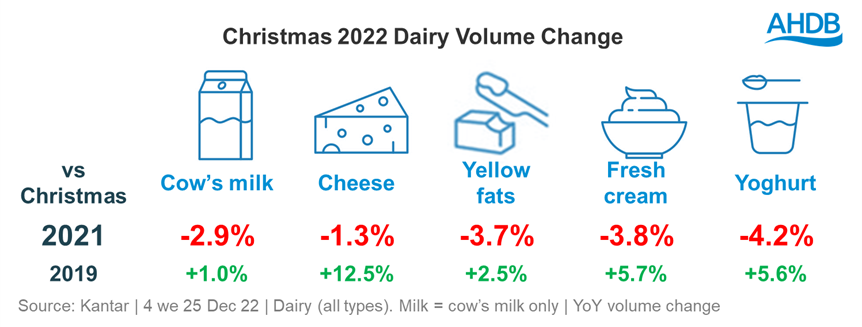Christmas spend on dairy hits a high despite lower retail volumes
Tuesday, 7 February 2023
In the run up to Christmas, 53% of Brits expected to spend less for Christmas 2022 (IGD), and we saw this materialise in the sales data. Inflation was the driving force behind significant market growth, as households actually scaled back the amount of volume they purchased. The value of the biggest shop increased by nearly £5, to reach £78.55 (Kantar).
Dairy category performance
Spend on dairy rose to its highest value in the last five years but, as with much of the rest of the market, volume decreased year on year. This was seen across all dairy categories. However, compared to 2019, we see longer-term volume growth for all the main dairy categories.

Cheese varieties
There were indications that shoppers cut back on the big cheese board this Christmas. For the likes of Stilton, Wensleydale and fruit/flavoured/smoked cheeses, volumes declined as cheese shoppers dropped these varieties from their baskets this Christmas. The main variety to gain the month of December was feta & salad cheese, where volumes rose by nearly 35%, primarily due to an increase in the number of households buying this type of cheese, particularly at the hard discounters.
Cream types
Christmas is a key time for cream sales, with 14% of 2022’s volumes sold in December alone. Within cream, single cream was the best performing (+9% year-on-year) as more households bought this type of cream. For aerosol cream, Christmas is even more importance, with 20% of volume sold in this month – rising 5% in the four-week period, likely linked to an increase in price promotions. Synthetic cream, where Elmlea is the market leader, was the worst performer, accounting for the majority of total cream volume losses.
Dairy alternatives
Dairy alternatives remained in growth this Christmas (+3.0%), although it’s worth noting that this growth has gradually slowed each year. This year-on-year growth comes entirely from milk alternatives, as other dairy alternative products, like yogurt and cheese, saw a decline. Milk alternative growth is driven by private label, rather than brands, which is linked to growth through the hard discounters.
Value tier gains
At a total grocery level, the premium tier took a bigger share of the year, as usual, but sales growth was behind that of the value tier. This was a trend also seen in dairy, where value lines gained from all other tiers, while brands lost out. In cheese, value private label increased its share from 13% last December, to 20% this year. Even in milk, where private label accounted for 84% of sales in December 2021, it managed to gain share (+1.4ppt), at the expense of brands.
Switching to the discounters
Total grocery spend at the discounters outpaced the rest of the market, up 21% versus the market backdrop of 9%. Supermarkets still see the most spend passing through their doors. This was a trend seen in dairy, where the discounters managed to attract new shoppers, including direct switching gains from the other retailers.
The discounters achieved volume growth across all the major dairy categories, with yellow fats seeing the strongest growth of +19.0% (compared to total retailers decline of -3.7% for yellow fats). Dairy spreads achieved the fastest growth within this (+27.0%) and, while block butter still achieved growth (7.7%), it lagged behind the other products within yellow fats. This highlights a challenge for block butter, as its price point rises and consumers switch out to cheaper options. Read more about how we think this will influence retail sales of yellow fats as part of our Agri Market Outlook.
Sign up to receive the latest information from AHDB
While AHDB seeks to ensure that the information contained on this webpage is accurate at the time of publication, no warranty is given in respect of the information and data provided. You are responsible for how you use the information. To the maximum extent permitted by law, AHDB accepts no liability for loss, damage or injury howsoever caused or suffered (including that caused by negligence) directly or indirectly in relation to the information or data provided in this publication.
All intellectual property rights in the information and data on this webpage belong to or are licensed by AHDB. You are authorised to use such information for your internal business purposes only and you must not provide this information to any other third parties, including further publication of the information, or for commercial gain in any way whatsoever without the prior written permission of AHDB for each third party disclosure, publication or commercial arrangement. For more information, please see our Terms of Use and Privacy Notice or contact the Director of Corporate Affairs at info@ahdb.org.uk © Agriculture and Horticulture Development Board. All rights reserved.
Topics:
Sectors:
Tags:

